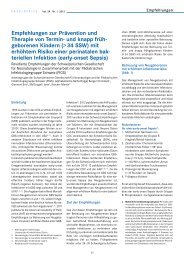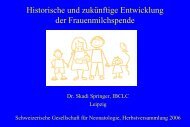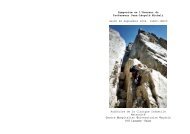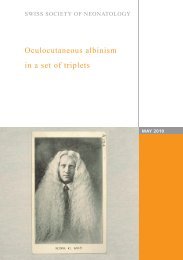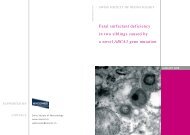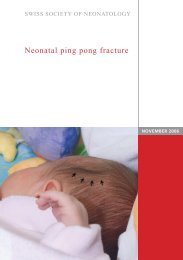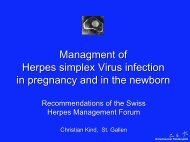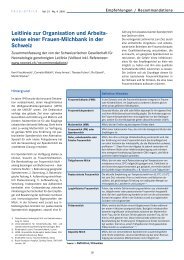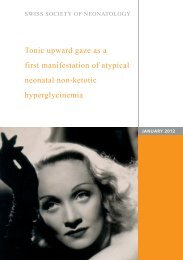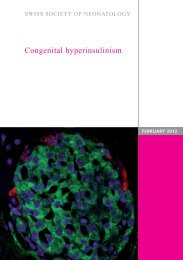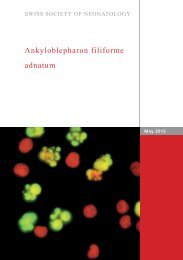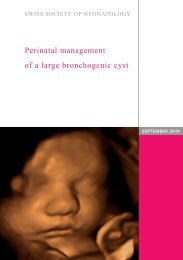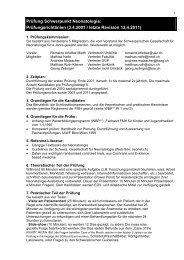Prise en charge et réanimation du nouveau-né - Swiss Society of ...
Prise en charge et réanimation du nouveau-né - Swiss Society of ...
Prise en charge et réanimation du nouveau-né - Swiss Society of ...
You also want an ePaper? Increase the reach of your titles
YUMPU automatically turns print PDFs into web optimized ePapers that Google loves.
Recommandations<br />
Tube <strong>en</strong>dotrachéal 2 kg<br />
34 SAG<br />
dication év<strong>en</strong>tuelle: prés<strong>en</strong>ce d’une dépression<br />
respiratoire chez un <strong>nouveau</strong>-<strong>né</strong> dont<br />
la mère a reçu un opiacé dans les 4 heures<br />
précédant la naissance.<br />
Dose: 0.1 mg/kg intraveineux ou intramusculaire.<br />
L’application intra-trachéale <strong>et</strong><br />
sous-cuta<strong>né</strong>e sont à proscrire k) . La demivie<br />
de la naloxone est <strong>en</strong> gé<strong>né</strong>ral plus<br />
courte que celle des opiacé administrés.<br />
Pour c<strong>et</strong>te raison, une surveillance <strong>du</strong>rant<br />
les 24 premières heures est <strong>né</strong>cessaire.<br />
Contre-indication: <strong>nouveau</strong>-<strong>né</strong>s de mère toxicodép<strong>en</strong>dantes<br />
aux opiacés (anamnèse!).<br />
Cave: La préparation Naloxon-<strong>né</strong>onatal<br />
(0.02 mg/ml) ne doit plus être utilisée.<br />
Liste 2<br />
Équipem<strong>en</strong>t de base pour un accouchem<strong>en</strong>t<br />
à domicile<br />
• Ligne téléphonique (les numéros <strong>du</strong> service<br />
d’ambulance <strong>et</strong> de l’hôpital doiv<strong>en</strong>t<br />
être connus).<br />
• Chauffage de la pièce <strong>et</strong> bon éclairage.<br />
• Une surface matelassée à hauteur de table.<br />
• Linges <strong>et</strong> gants.<br />
• Dispositif d’aspiration buccale <strong>et</strong> sondes<br />
d’aspiration.<br />
• Ballon de v<strong>en</strong>tilation (p. ex. Baby Ambu<br />
ou Laerdal avec réservoir) <strong>et</strong> masques<br />
(p. ex Laerdal 00 <strong>et</strong> 01).<br />
• Masque à oxygène <strong>et</strong> connections pour O 2 .<br />
• Cylindre à oxygène avec un débitmètre<br />
(jusqu’à 6–10 L/min).<br />
k) La dose de naloxone de 0.1 mg/kg recommandée<br />
par l’AAP n’est pas fondée sur l’évid<strong>en</strong>ce 65) .<br />
• Couverture plastique<br />
• Pulsoxymètre.<br />
• Protocole de <strong>réanimation</strong>.<br />
• Pinces ombilicales, ciseaux ombilicaux.<br />
• Chronomètre, montre Apgar<br />
• Stéthoscope.<br />
• Thermomètre.<br />
• Appareil à mesure de la glycémie.<br />
Remerciem<strong>en</strong>ts<br />
Ces recommandations ont été soumises à tous les<br />
membres de la Société Suisse de Néonatologie, ainsi<br />
qu’au comité directeur de la Société Suisse de Gy<strong>né</strong>cologie<br />
<strong>et</strong> Obstétrique (SSGO), de la Société Suisse<br />
d’Anesthésiologie <strong>et</strong> de Réanimation (SSAR), de la Société<br />
Suisse de Pédiatrie <strong>et</strong> à la Fédérations Suisse de<br />
Sages-Femmes. Nous remercions tous ceux qui ont<br />
participé à leur révision. Tous les dessins ont été réalisés<br />
par M. Stefan Schwyter <strong>du</strong> service graphique <strong>du</strong><br />
départem<strong>en</strong>t de chirurgie de l’Hôpital universitaire de<br />
Zürich.<br />
Référ<strong>en</strong>ces<br />
1) Perlman JM, Wyllie J, Kattwinkel J, Atkins DL, Chameides<br />
L, Goldsmith JP, <strong>et</strong> al. Part 11: neonatal resuscitation:<br />
2010 International Cons<strong>en</strong>sus on Cardiopulmonary<br />
Resuscitation and Emerg<strong>en</strong>cy<br />
Cardiovascular Care Sci<strong>en</strong>ce With Treatm<strong>en</strong>t Recomm<strong>en</strong>dations.<br />
Circulation 2010; 122: S 516–38.<br />
2) Canadian NRP Steering Committee. Recomm<strong>en</strong>dations<br />
for specific treatm<strong>en</strong>t modifications in the<br />
Canadian context. Add<strong>en</strong><strong>du</strong>m to the 2006 NRP<br />
Provider Textbook 2007.<br />
3) Kattwinkel J, Perlman JM, Aziz K, Colby C, Fairchild<br />
K, Gallagher J, <strong>et</strong> al. Part 15: Neonatal Resuscitation:<br />
2010 American Heart Association Guidelines<br />
for Cardiopulmonary Resuscitation and Emerg<strong>en</strong>cy<br />
Cardiovascular Care. Circulation 2010; 122: S<br />
909–19.<br />
4) Morley C. New Australian Neonatal Resuscitation<br />
Guidelines. J Paediatr Child Health 2007; 43: 6–8.<br />
5) Richmond S, Wyllie J. European Resuscitation<br />
Council Guidelines for Resuscitation 2010 Section<br />
7. Resuscitation <strong>of</strong> babies at birth. Resuscitation<br />
2010; 81: 1389–99.<br />
6) Richmond S, Wyllie J, on Behalf <strong>of</strong> the Resuscitation<br />
Council (UK). Newborn Life Support: Resuscitation<br />
Guidelines 2010. In: (UK) RC, editor.2010.<br />
22<br />
3 kg<br />
37 SAG<br />
Vol. 23 No. 1 2012<br />
4 kg<br />
40 SAG<br />
Taille (ID <strong>en</strong> mm) ID 3.0 ID 3.5 ID 3.5<br />
Pr<strong>of</strong>ondeur d’insertion orale 8 9 10<br />
Pr<strong>of</strong>ondeur d’insertion nasale 9.5 10.5 11.5<br />
Médicam<strong>en</strong>ts dose préparation/indications 2 kg<br />
34 SAG<br />
Adr<strong>en</strong>aline 1:1000<br />
(Amp. à 1 mg/ml)<br />
NaCl 0.9%<br />
Ringer lactate<br />
Intraveineux:<br />
10 - 30 mcg/kg<br />
Intratrachéal:<br />
50-100 mcg/kg<br />
Glucose 10% 4–6 mg/kg/min<br />
2 ml/kg<br />
1 ml + 9 ml NaCl 0.9%<br />
(1 : 10 000 d. h. 1 ml = 100 mcg)<br />
3 kg<br />
37 SAG<br />
4 kg<br />
40 SAG<br />
0.2–0.6 ml 0.3–0.9 ml 0.4–1.2 ml<br />
1–2 ml 1.5–3 ml 2–4 ml<br />
10 ml/kg Bolus de remplissage i. v. 20 ml 30 ml 40 ml<br />
Perfusion de glucose<br />
Hypoglycémie symptomatique<br />
6 ml/h<br />
4 ml<br />
9 ml/h<br />
6 ml<br />
12 ml/h<br />
8 ml<br />
7) Saugstad OD. New guidelines for newborn resuscitation<br />
– a critical evaluation. Acta Paediatr 2011;<br />
100: 1058–62.<br />
8) Saugstad O. Practical aspects <strong>of</strong> resuscitating newborn<br />
infants. Eur J Pediatr 1998; 157 (suppl 1): S 11–S 5.<br />
9) <strong>Swiss</strong> Soci<strong>et</strong>y <strong>of</strong> Neonatology. start4neo (<strong>Swiss</strong><br />
Neonatal Resuscitation Training: Interpr<strong>of</strong>essional<br />
Training Programme for Neonatal Care and Resuscitation).<br />
2011; Available from: http://www.neon<strong>et</strong>.ch.<br />
10) Pediatric Working Group <strong>of</strong> the International Liaison<br />
Committee on Resuscitation. Resuscitation <strong>of</strong> the<br />
newly born infant. Pediatrics 1999; 103: 1–13.<br />
11) Mercer JS, Vohr BR, McGrath MM, Padbury JF, Wallach<br />
M, Oh W. Delayed cord clamping in very pr<strong>et</strong>erm<br />
infants re<strong>du</strong>ces the incid<strong>en</strong>ce <strong>of</strong> intrav<strong>en</strong>tricular<br />
hemorrhage and late-ons<strong>et</strong> sepsis: a randomized,<br />
controlled trial. Pediatrics 2006; 117: 1235–42.<br />
12) Rabe H, Reynolds G, Diaz-Rossello J. Early versus<br />
delayed umbilical cord clamping in pr<strong>et</strong>erm infants.<br />
The Cochrane Database Syst Rev 2006; 3:<br />
CD003248.<br />
13) Ibrahim HM, Krouskop RW, Lewis DF, Dhanireddy<br />
R. Plac<strong>en</strong>tal transfusion: umbilical cord clamping<br />
and pr<strong>et</strong>erm infants. J Perinatol 2000; 20: 351–4.<br />
14) Linderkamp O, Nelle M, Kraus M, Zilow EP. The effect<br />
<strong>of</strong> early and late cord-clamping on blood viscosity<br />
and other hemorheological param<strong>et</strong>ers in full-term<br />
neonates. Acta Paediatr 1992; 81: 745–50.<br />
15) Nelle M, Zilow EP, Bastert G, Linderkamp O. Effect<br />
<strong>of</strong> Leboyer childbirth on cardiac output, cerebral<br />
and gastrointestinal blood flow velocities in fullterm<br />
neonates. Am J Perinatol 1995; 12: 212–6.<br />
16) Rabe H, Reynolds G, Diaz-Rossello J. Early versus<br />
delayed umbilical cord clamping in pr<strong>et</strong>erm infants.<br />
Cochrane Database Syst Rev, Update 2005 2004:<br />
CD003248.<br />
17) Rabe H, Jewison A, Alvarez RF, Crook D, Stilton D,<br />
Bradley R, <strong>et</strong> al. Milking compared with delayed<br />
cord clamping to increase plac<strong>en</strong>tal transfusion in<br />
pr<strong>et</strong>erm neonates: a randomized controlled trial.<br />
Obst<strong>et</strong> Gynecol 2011; 117: 205–11.<br />
18) O’Donnell CP, Kamlin CO, Davis PG, Carlin JB, Morley<br />
CJ. Clinical assessm<strong>en</strong>t <strong>of</strong> infant colour at delivery.<br />
Arch Dis Child F<strong>et</strong>al Neonatal Ed 2007; 92: F 465–7.<br />
19) Kamlin CO, O’Donnell CP, Davis PG, Morley CJ.<br />
Oxyg<strong>en</strong> saturation in healthy infants immediately<br />
after birth. J Pediatr 2006; 148: 585–9.<br />
20) Rabi Y, Yee W, Ch<strong>en</strong> SY, Singhal N. Oxyg<strong>en</strong> saturation<br />
tr<strong>en</strong>ds immediately after birth. J Pediatr 2006;<br />
148: 590–4.<br />
21) Andres V, Garcia P, Rim<strong>et</strong> Y, Nicaise C, Simeoni U.<br />
Appar<strong>en</strong>t life-threat<strong>en</strong>ing ev<strong>en</strong>ts in presumably



